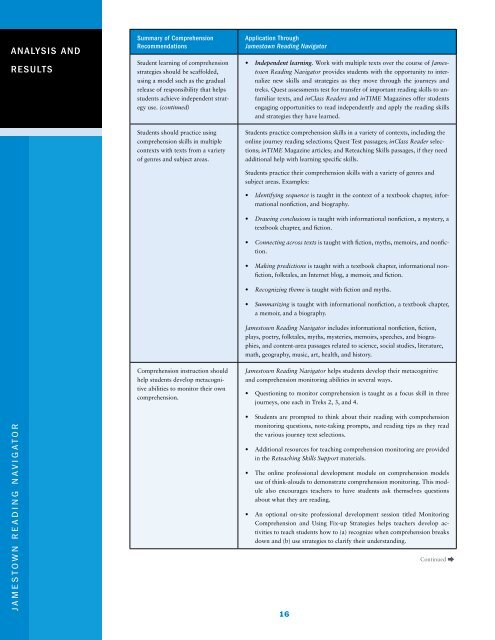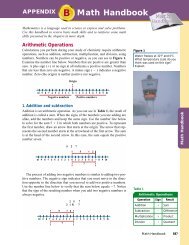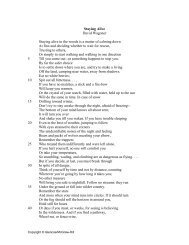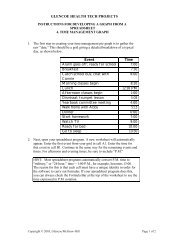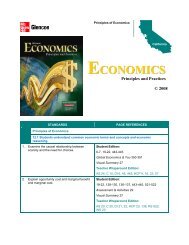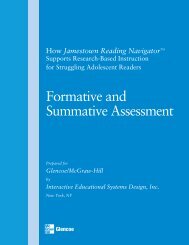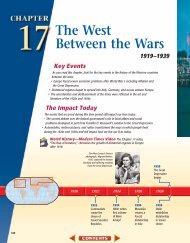Comprehension - Research
Comprehension - Research
Comprehension - Research
You also want an ePaper? Increase the reach of your titles
YUMPU automatically turns print PDFs into web optimized ePapers that Google loves.
ANALYSIS AND<br />
RESULTS<br />
Summary of <strong>Comprehension</strong><br />
Recommendations<br />
Student learning of comprehension<br />
strategies should be scaffolded,<br />
using a model such as the gradual<br />
release of responsibility that helps<br />
students achieve independent strategy<br />
use. (continued)<br />
Application Through<br />
Jamestown Reading Navigator<br />
• Independent learning. Work with multiple texts over the course of Jamestown<br />
Reading Navigator provides students with the opportunity to internalize<br />
new skills and strategies as they move through the journeys and<br />
treks. Quest assessments test for transfer of important reading skills to unfamiliar<br />
texts, and inClass Readers and inTIME Magazines offer students<br />
engaging opportunities to read independently and apply the reading skills<br />
and strategies they have learned.<br />
Students should practice using<br />
comprehension skills in multiple<br />
contexts with texts from a variety<br />
of genres and subject areas.<br />
Students practice comprehension skills in a variety of contexts, including the<br />
online journey reading selections; Quest Test passages; inClass Reader selections;<br />
inTIME Magazine articles; and Reteaching Skills passages, if they need<br />
additional help with learning specific skills.<br />
Students practice their comprehension skills with a variety of genres and<br />
subject areas. Examples:<br />
• Identifying sequence is taught in the context of a textbook chapter, informational<br />
nonfiction, and biography.<br />
• Drawing conclusions is taught with informational nonfiction, a mystery, a<br />
textbook chapter, and fiction.<br />
• Connecting across texts is taught with fiction, myths, memoirs, and nonfiction.<br />
• Making predictions is taught with a textbook chapter, informational nonfiction,<br />
folktales, an Internet blog, a memoir, and fiction.<br />
• Recognizing theme is taught with fiction and myths.<br />
• Summarizing is taught with informational nonfiction, a textbook chapter,<br />
a memoir, and a biography.<br />
Jamestown Reading Navigator includes informational nonfiction, fiction,<br />
plays, poetry, folktales, myths, mysteries, memoirs, speeches, and biographies,<br />
and content-area passages related to science, social studies, literature,<br />
math, geography, music, art, health, and history.<br />
J a m e s t o w n R e a d i n g N a v i g a t o r<br />
<strong>Comprehension</strong> instruction should<br />
help students develop metacognitive<br />
abilities to monitor their own<br />
comprehension.<br />
Jamestown Reading Navigator helps students develop their metacognitive<br />
and comprehension monitoring abilities in several ways.<br />
• Questioning to monitor comprehension is taught as a focus skill in three<br />
journeys, one each in Treks 2, 3, and 4.<br />
• Students are prompted to think about their reading with comprehension<br />
monitoring questions, note-taking prompts, and reading tips as they read<br />
the various journey text selections.<br />
• Additional resources for teaching comprehension monitoring are provided<br />
in the Reteaching Skills Support materials.<br />
• The online professional development module on comprehension models<br />
use of think-alouds to demonstrate comprehension monitoring. This module<br />
also encourages teachers to have students ask themselves questions<br />
about what they are reading.<br />
• An optional on-site professional development session titled Monitoring<br />
<strong>Comprehension</strong> and Using Fix-up Strategies helps teachers develop activities<br />
to teach students how to (a) recognize when comprehension breaks<br />
down and (b) use strategies to clarify their understanding.<br />
16<br />
Continued 2


